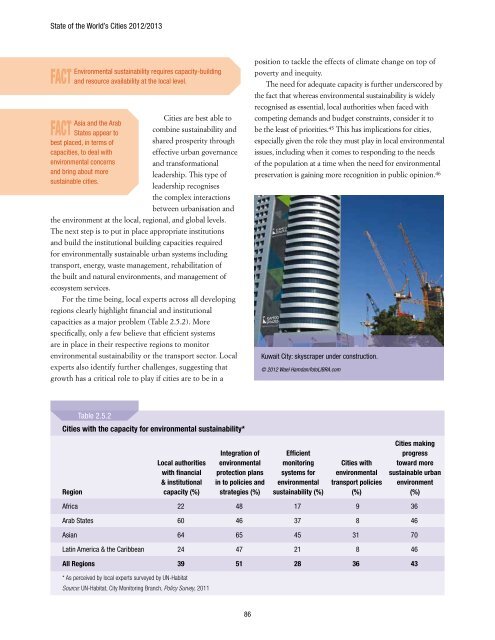Environmental Sustainability and <strong>the</strong> Prosperity <strong>of</strong> CitiesThe manufacture <strong>of</strong> bicycles is dominated by China,India and <strong>the</strong> European Union, all <strong>of</strong> which account for87 per cent <strong>of</strong> global production. However, China aloneproduces more than half <strong>the</strong> world’s bicycles.Drivers and Capacity-Building forEnvironmental Sustainability<strong>Sustainable</strong> urban policies are driven by seven mainfactors: availability <strong>of</strong> financial resources, human resources,appropriate technology, specialised institutions, access toinformation, adequate organisational arrangements, andsupportive legal frameworks.Approximately one-third <strong>of</strong> local experts across allregions are <strong>of</strong> <strong>the</strong> view that mechanisms for coordinationbetween city and national authorities regardingenvironmental sustainability are already in place(Table 2.5.1). Less than one-third report that <strong>cities</strong> aremobilising investment to support sustainable resource use,or pulling <strong>the</strong>ir resources toge<strong>the</strong>r in order to enhanceenvironmental sustainability.These efforts can only go so far, it would seem, asexperts simultaneously highlight <strong>the</strong> widespread problem <strong>of</strong>inadequate capacity. This refers to lack <strong>of</strong> not just finance,but also effective arrangements to facilitate partnershipswith stakeholders, toge<strong>the</strong>r with weak institutionalframeworks and poor urban governance structures. 44 Theseconditions have drastically restraining effects on <strong>cities</strong>’ability for effective mitigation and adaptation.Similarly, <strong>cities</strong> and local authorities in developingcountries may find it difficult to prioritize environmentalpolicyPublic transport jobs account for 1–2 per cent <strong>of</strong>total employment in many countries. In Europeand <strong>the</strong> USA, some 30 jobs are created for every USD 1.4million invested in public transport infrastructure, and ano<strong>the</strong>r57 in transport operations proper. 42policyPilot projects in <strong>the</strong> Philippines suggest thatretr<strong>of</strong>its <strong>of</strong> two-stroke engines on two- andthree-wheeled vehicles − <strong>the</strong> most popular public transportin many developing countries − has cut fuel consumptionby 35–50 per cent and emissions <strong>of</strong> air pollutants by asmuch as 90 per cent. Installing and servicing <strong>the</strong> kits createsemployment. 43sustainability issues and challenges over and aboveunemployment, poverty, housing shortages, infrastructuresand services, especially where local political expediencydemands this type <strong>of</strong> action.This underscores <strong>the</strong> importance <strong>of</strong> growth andprosperity to <strong>the</strong> capacity <strong>of</strong> <strong>cities</strong> to address urbanenvironmental sustainability issues, and this is also why<strong>the</strong>y must be innovative and inventive when dealing withhistoric urban environmental problems while shaping anenvironmentally sustainable future. This situation highlights<strong>the</strong> fact that <strong>the</strong> twin dynamics <strong>of</strong> sustainability and economicprosperity are inevitably subject to a number <strong>of</strong> structuralconstraints that are specific to each and every urban arearegardless <strong>of</strong> size.Table 2.5.1Drivers <strong>of</strong> Environmental Sustainability in Cities*RegionsAvailable mechanism(s) forcoordination between local andnational authorities concerningsustainability (%)Leveraging <strong>of</strong> investments tosupport sustainable resourceuse and lower greenhousegas emissions (%)Municipalities in same city/region combining resources& partnering toge<strong>the</strong>r forenhanced environmentalsustainability (%)Africa 31 20 20Arab States 37 35 35Asia 48 49 48Latin America & Caribbean 26 18 20All Regions 34 29 29* As perceived by local experts surveyed by UN-HabitatSource: UN-Habitat, City Monitoring Branch, Policy Survey, 201185
State <strong>of</strong> <strong>the</strong> World’s Cities <strong>2012</strong>/<strong>2013</strong>factfactEnvironmental sustainability requires capacity-buildingand resource availability at <strong>the</strong> local level.Cities are best able toAsia and <strong>the</strong> ArabStates appear tocombine sustainability andbest placed, in terms <strong>of</strong>shared prosperity throughcapa<strong>cities</strong>, to deal wi<strong>the</strong>ffective urban governanceenvironmental concerns and transformationaland bring about moreleadership. This type <strong>of</strong>sustainable <strong>cities</strong>.leadership recognises<strong>the</strong> complex interactionsbetween urbanisation and<strong>the</strong> environment at <strong>the</strong> local, regional, and global levels.The next step is to put in place appropriate institutionsand build <strong>the</strong> institutional building capa<strong>cities</strong> requiredfor environmentally sustainable urban systems includingtransport, energy, waste management, rehabilitation <strong>of</strong><strong>the</strong> built and natural environments, and management <strong>of</strong>ecosystem services.For <strong>the</strong> time being, local experts across all developingregions clearly highlight financial and institutionalcapa<strong>cities</strong> as a major problem (Table 2.5.2). Morespecifically, only a few believe that efficient systemsare in place in <strong>the</strong>ir respective regions to monitorenvironmental sustainability or <strong>the</strong> transport sector. Localexperts also identify fur<strong>the</strong>r challenges, suggesting thatgrowth has a critical role to play if <strong>cities</strong> are to be in aposition to tackle <strong>the</strong> effects <strong>of</strong> climate change on top <strong>of</strong>poverty and inequity.The need for adequate capacity is fur<strong>the</strong>r underscored by<strong>the</strong> fact that whereas environmental sustainability is widelyrecognised as essential, local authorities when faced withcompeting demands and budget constraints, consider it tobe <strong>the</strong> least <strong>of</strong> priorities. 45 This has implications for <strong>cities</strong>,especially given <strong>the</strong> role <strong>the</strong>y must play in local environmentalissues, including when it comes to responding to <strong>the</strong> needs<strong>of</strong> <strong>the</strong> population at a time when <strong>the</strong> need for environmentalpreservation is gaining more recognition in public opinion. 46Kuwait City: skyscraper under construction.© <strong>2012</strong> Wael Hamdan/fotoLIBRA.comTable 2.5.2Cities with <strong>the</strong> capacity for environmental sustainability*RegionLocal authoritieswith financial& institutionalcapacity (%)Integration <strong>of</strong>environmentalprotection plansin to policies andstrategies (%)Efficientmonitoringsystems forenvironmentalsustainability (%)Cities wi<strong>the</strong>nvironmentaltransport policies(%)Cities makingprogresstoward moresustainable urbanenvironment(%)Africa 22 48 17 9 36Arab States 60 46 37 8 46Asian 64 65 45 31 70Latin America & <strong>the</strong> Caribbean 24 47 21 8 46All Regions 39 51 28 36 43* As perceived by local experts surveyed by UN-HabitatSource: UN-Habitat, City Monitoring Branch, Policy Survey, 201186





